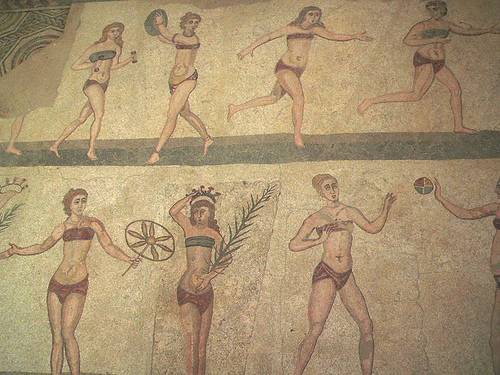
Officially, the modern bikini was invented in Paris in 1946, but women’s two-piece athletic garments go back to 1400 B.C. This mosaic, found in a Roman villa near Sicily, dates from 300 A.D. Evidently they had fans.

Officially, the modern bikini was invented in Paris in 1946, but women’s two-piece athletic garments go back to 1400 B.C. This mosaic, found in a Roman villa near Sicily, dates from 300 A.D. Evidently they had fans.
Religious demographics of the United States Senate:
Non-religious or religiously unspecified people make up 15% of the U.S. population … but there’s no sign of them in the Senate.
In 1998, University of Iowa communications professor Kembrew McLeod trademarked the phrase “Freedom of Expression.” Then he sent AT&T a cease-and-desist letter because they were using his phrase in an advertising campaign.
He said he knew he was overreaching, but “I do want to register my genuine protest that a big company that really doesn’t represent freedom of expression is trying to appropriate this phrase.”
From Manners and Conduct in School and Out by the Deans of Girls in Chicago High Schools, 1921:

Now decried as racist, “human zoos” attracted millions to fairs and exhibitions in the 19th century.
They purported to show how other peoples lived in their “primitive” state, but they often revealed more about their white organizers.
In 1906, the Bronx Zoo exhibited a Congolese pygmy next to an orangutan, as an example of the “missing link.” The pygmy was finally removed after a public outcry. Clergyman James H. Gordon said, “Our race, we think, is depressed enough, without exhibiting one of us with the apes.”
In 1958 a rhinoceros ran for the city council of São Paulo, Brazil.
“Cacareco,” who lived at the city zoo, was nominated as a protest against political corruption.
Officials rejected his candidacy, but he received 100,000 votes anyway, more than any other party.
Brazilians still describe a protest vote as a “Voto Cacareco” (Cacareco vote).
World’s most expensive cities, according to a worldwide 2006 cost of living survey by Mercer Human Resource Consulting:
New York was number 11.

“A Bawd is the Refuse of an Old Whore, who having been burnt herself, does like Charcoal help to set greener Wood on Fire; She is one of Natures Errata’s, and a true Daughter of Eve, who having first undone herself, tempts others to the same Destruction. She has formerly been one of Sampson’s Foxes, and has carried so much fire in her Tail, as has burnt all those that have had to do with her: But the mark being out of her Mouth, and she grown past her own Labour, yet being a well-wisher to the Mathematicks, she sets up for a Procurer of fresh Goods for her old Customers. And so careful she is to help Men to good Ware, that she seldom puts a Comodity into their hands, but what has been try’d before; and having always prov’d well, thinks she can Warrant ’em the better. She’s a great Preserver of Maiden-heads; for tho’ she Exposes ’em to every new Comer, she takes care that they shall never be lost: And tho’ never so many get it, yet none carries it away, but she still has it ready for the next Customers.”
— The London-Bawd: With Her Character and Life: Discovering the Various and Subtle Intrigues of Lewd Women, 1705
Oprah Winfrey is the world’s only black billionaire.
Woman, thou worst of all Church-plagues, farewel;
Bad at the best, but at the worst a Hell;
Thou truss of wormwood, bitter Teaz of Life,
Thou Nursery of humane cares a wife.
Thou Apple-Eating Trayt’riss who began
The Wrath of Heav’n, and Miseries of Man,
And hast with never-failing diligence,
Improv’d the Curse to humane Race e’er since.
Farewel Church-juggle that enslav’d my Life,
But bless that Pow’r that rid me of my Wife.
And now the Laws once more have set me free,
If Woman can again prevail with me,
My Flesh and Bones shall make my Wedding-Feast,
And none shall be Invited as my Guest,
T’ attend my Bride, but th’ Devil and a Priest.
— From The Pleasures of a Single Life, or, The Miseries of Matrimony, 1709